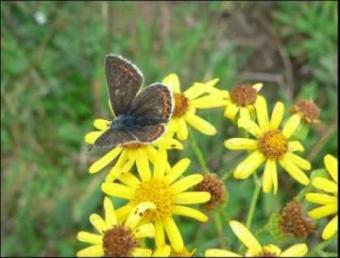
Warming temperatures have been shown to have both positive and negative effects on populations of British butterflies. Species at the northern limit of their ranges have been able to expand their ranges, moving northwards throughout the UK. Species such as Orange-tip and Peacock have become common in Scotland as the climate has become suitable. Silver-spotted Skipper has been able to colonise new habitats on north facing slopes, having previously been mainly restricted to south facing slopes. Similarly, temperature rises have also been associated with increases in Adonis Blue populations. Recent research has also shown that warming temperatures have facilitated the spread of the Brown Argus throughout England through increased use of host plants it previously only rarely used.
Migrant species have also increased in number in response to recent warming. Red Admiral, in particular, and Clouded Yellow to a lesser extent, now regularly over-winter in the UK to produce resident populations due to increasingly favourable conditions.
The story is likely to be the reverse for those species at their southern range limit in the UK with evidence to suggest that their ranges are contracting at the southern edge and/or at lower elevations, a result echoed in studies elsewhere in Europe. Population responses of these species are mixed, however, as numbers of Scotch Argus and Large Heath have both increased on monitored sites, whilst Northern Brown Argus has declined.
In addition, most species have started to appear progressively earlier in the year, and this has been strongly linked with increased temperatures. A number of species are now able to produce more than one brood in warm years, and this is increasingly observed at monitored sites. For example, Wood White now regularly produces a second brood at most sites where it is monitored, whereas at the start of monitoring this was a much rarer occurrence. Meta-analyses have shown that butterflies and other primary consumers may be advancing at different rates to both their hosts and their predators leading to concerns over potential temporal mismatching in trophic interactions.
Recent rapid range expansion in the Brown Argus is associated with increased use of geranium species as host plants brought about by climatic suitability with recent warming: Pateman et al. (2012) in Science (doi: 10.1126/science.1216980)
Community composition changes are rapid but different between birds and butterflies. Both groups do not keep up with temperature increases and suggest a climatic debt at national and continental scales. Devictor et al. (2012) in Nature Climate Change (doi:10.1038/nclimate1347)
Population density but not stability can be predicted from species distribution models. Oliver et al. (2012) in Journal of Applied Ecology (doi: 10.1111/j.1365-2664.2012.02138.x)
Diet breadth, overwintering stage and range size affect butterfly phenology. Species with narrow larval diet breadths and more advanced overwintering stages, as well as those with smaller ranges, have shown the greatest advancements in their date of first appearance. Diamond et al. (2011) in Global Change Biology (doi:10.1890/10-1594.1)
Predicting insect phenology across space and time. Hodgson et al. (2011) in Global Change Biology (doi: 10.1111/j.1365-2486.2010.02308.x)
Differences in the rate of advance of biological events between plants and consumers suggests potential for temporal mis-matching in key trophic interactions. Meta-analyses have shown that many biological events across multiple taxa and ecosystems are occurring earlier in the year consistent with recent climate warming. However, the rate of these advances are not equal across different trophic levels, being greatest in plants and least in secondary consumers Thackeray et al. (2010) in Global Change Biology (doi: 10.1111/j.1365-2486.2010.02165.x)




